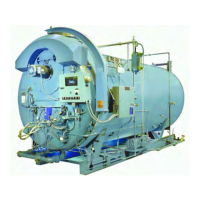Chapter 4 — Sequence of Operation
4-4 Part No. 750-184
•Main gas valve (MGV)
• Main gas vent valve (MGVV) (if provided)
• Oil valve (OV)
• Main fuel valve light (FVL)
Firing Rate Circuit
• Damper motor transformer (DMT)
• Modulating damper motor (MDM)
• Manual-automatic switch (MAS)
• Manual flame control (MFC)
•Modulating control (MC)
To comply with requirements of insurance underwriters such as Factory
Mutual (FM), Industrial Risk Insurers (IRI) or others, additional interlock
devices may be used in addition to the circuits mentioned in section B.
High Fire Proving Circuit
• High fire switch (HFS)
Running Interlock and Limit Circuit
• Low oil pressure switch (LOPS)
• High oil pressure switch (HOPS)
• High oil temperature switch (HOTS)
• Auxiliary low-water cutoff (ALWCO)
C. SEQUENCE OF OPERATION - OIL OR GAS
On a combination fuel unit, the gas/oil switch must be set for the proper fuel.
The following sequence occurs with power present at the program relay (PR)
input terminals and with all other operating conditions satisfied.
Pre-Purge Cycle - When the burner switch (BS) is turned “on,” and controls
wired in the “limit” and “fuel valve interlock” circuits are closed and no flame
signal is present, the “blower motor start circuit” is powered energizing the
blower motor starter (BMS). The load demand light (LDL) turns on. When
firing oil, the air compressor motor starter (ACMS) (if provided) is also
powered. Air purge valve (APV) (Nos. 5 and 6 oil only) remains deenergized.
At the same time, the program relay signals the modulating damper motor
(MDM) to open the air damper. The damper begins to open and drives to its
full open or high fire position. Opening the damper motor allows a flow of
purging air through the boiler prior to the ignition cycle.
On certain boilers the circuitry will include a high fire switch (HFS). The
purpose of the switch is to prove that the modulating damper motor (MDM)
has driven the damper to the open position during the pre-purge cycle. In
this instance, the “high fire proving circuit” is utilized.
The controls wired into the “running interlock circuit” must be closed within
10 seconds after the start sequence. In the event any of the controls are not

